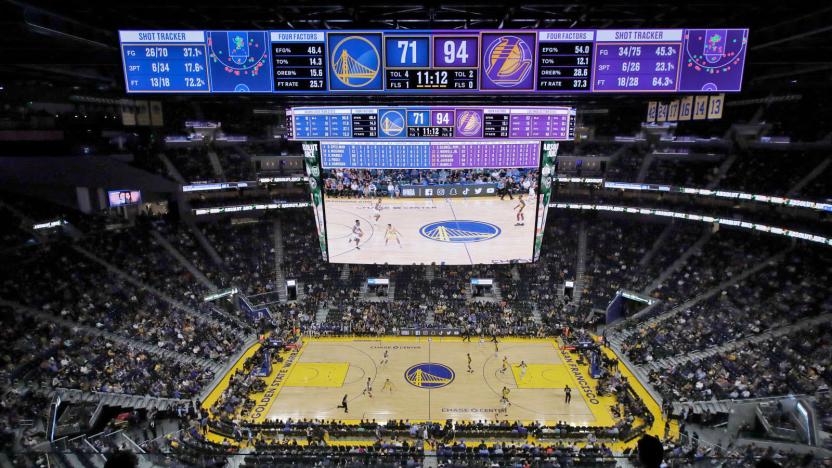internet speed
Latest

AT&T and Comcast improve internet access in response to COVID-19
With so many people in the US working and learning from home, as offices and schools close in response to the coronavirus pandemic, internet service providers (ISPs) are beginning to react. Comcast is increasing internet speeds for low-income users, and AT&T told Motherboard that it is suspending all broadband usage caps until further notice.

Verizon's sports arena 5G doesn't reach every seat
Last week, Verizon (Engadget's parent company) bragged about offering 5G coverage in three major basketball and hockey arenas. Turns out there's a pretty big catch. That 5G is only available in some of the seating areas.

Verizon enlists Boingo to help it bring 5G indoors
Sure, real 5G is up to three times faster than LTE, but there are a few caveats. As we discovered in Chicago, 5G doesn't always hold up when you're trying to use it indoors. Even a pane of glass can cause your signal to flicker between 5G and 4G. Verizon (Engadget's parent company) and Boingo are hoping to change that. The companies are working together to bring 5G Ultra Wideband service to indoor public spaces, like airports, office buildings and stadiums.

Google, Cuba deal could bring faster internet to the island
Today, Google signed a memorandum with Cuba's telecom monopoly ETECSA to create a cost-free connection between the two networks. Doing so will boost Cuba's internet speeds, but this peering agreement comes with a catch. Cuba will first need to install a new undersea fiber-optic cable to physically connect its network with a Google "point of presence." And that could take years.

New National School Speed Test hopes to help all K-12 students get effective digital learning
With 99 percent of the nation's K-12 schools hooked-up to the internet, you'd think online learning was an educational staple. Sadly, it's also estimated that some 80 percent of those connections can't provide the 100Mbps per 1,000 students bandwidth the State Education Technology Directors Association recommends. That's why NPO EducationSuperHigway has announced the National School Speed Test initiative, with the goal to take actual stock of the state of internet connections in our schools. The NSST hopes to measure the internet capabilities of every K-12 school, and identify those that are lagging behind. Educational staff and students can also help out by checking their own school's speeds on a dedicated website (linked below). The results of the NSST will be open to the institutions themselves, districts and state departments of education, enabling them to better plan upgrade strategies for the future.

Internet speeds drop around the world according to Akamai, adoption rate up
Here's an odd one: average connection speeds around the globe dropped 14 percent to just 2.3 Mbps during the last quarter of 2011. The drop off remains something of a mystery since the data used to calculate that result doesn't include mobile broadband (so its increased adoption can't be dragging down the whole) and Akamai offers no explanation. Still, it's not time to start panicking, just yet. Even though speeds in the US dropped 5.3 percent from the previous quarter, average connection rates are still up significantly over the previous year. Otherwise, things largely stayed the same. Global broadband adoption was steady at 66 percent and the US continued to trail its friends across the Pacific (by a lot) in the race for the fastest Internet connections. Interestingly, while the number of broadband connections stayed consistent the number of narrowband lines (under 256 Kbps) declined dramatically. Yet, the percentage of the world's population connected to the web managed to increase 2.1 percent quarter over quarter -- and 13 percent for the year. So, while it may seem that the internet had a temporary set back in Q4 of 2011, the long term trends look good. The number of people online is increasing, the average speeds being pulled down by those people is climbing and the number of folks stuck in the dial up era is dropping. To get a copy of the full report hit up the source.

Microsoft's 'HTTP Speed + Mobility' aims to make the web faster, could be the next big ping
We're generally satisfied with our internet performance, but we wouldn't say no to a speed boost. A Microsoft blog post reveals plans to enable just that, with the company's proposed "HTTP Speed + Mobility" approach to HTTP 2.0. Have you thought about what life would be like with a faster internet? MS says Y-E-S! "There is already broad consensus about the need to make web browsing much faster," the company proclaimed. Juicy. The suggested protocol will, well, focus on achieving greater speed, but Microsoft hasn't detailed exactly how it will accomplish that, beyond mentioning that it's based on the Google SPDY protocol, which on its own aims to reduce latency and congestion by prioritizing requests and removing the limit on simultaneous streams over a single TCP connection. For its part, MS says it will be expanding on SPDY to "address the needs of mobile devices and applications," which we presume would be in Google's best interests as well. It's safe to say that Microsoft's being a bit more forthcoming during its meetings with the Internet Engineering Task Force (IETF) this week -- the organization responsible for creating HTTP 2.0 -- so perhaps we'll be hearing more about this fabled faster internet before we turn anew to Q2.

FCC measures US wireline advertised broadband speeds, fiber dominates cable and DSL
Ever wonder if the speeds your ISP advertises are actually what you're getting while reloading Engadget all day? The FCC did, and decided to team up with 13 major broadband providers in the US to test how they performed from February to June of this year. Notably, during peak hours the average continuous download speeds of fiber connections were 14 percent faster than advertised, while cable and DSL were slower than claimed by 8 and 18 percent, respectively. Upload speeds also varied, with DSL again dipping the lowest at 95-percent of what's advertised -- might be time to ask your phone-based ISP for a partial refund, no? In addition to sustained speeds, the FCC analyzed consumer connections' latency and the effect of ISP speed boost tech on activities like VoIP, gaming, and video streaming. In concluding its research, the Commission noted that it should be easy to get tools in users' hands for keeping better tabs on ISP-provided services, without needing to contact customer frustrations relations. The study is chock full of even more graphs and stats, which you'll find by hitting that source link below. Now, if only we could get those speeds on par with our friends across the Atlantic.

How fat are your tubes? Pando Networks studies average US net speeds
Pando Networks, a content delivery provider for a variety of free-to-play MMOs such as Lord of the Rings Online and MapleStory, has released a study on the average download speeds across the United States. To do this, the company tracked the download speeds of 4 million gamers' games and patches from January to June 2011. So what were the findings? Well, the fastest state in the US was Rhode Island, with an average of 894 KBps. The slowest state, with a download speed nearly a third of Rhode Island's, was Idaho, which came in with a rather paltry average of 318KBps. Perhaps unsurprisingly, the study also found that download speed averages tended to be highest in "fairly affluent, metropolitan suburbs," such as the prosperous Andover suburb of Boston. On the other end of the spectrum there are cities such as Yuma, AZ, Mission, TX, and Pocatello, ID, where speeds don't break 290 KBps. The study also got a look at the average speeds of major ISPs, with Comcast at the top spot with an average speed of 890KBps, and with Verizon (788KBps) and Cox (757KBps) coming in close behind. Roadrunner is the caboose of the group with a download speed average of 673KBps. Curious about how fat the interweb tubes are in your city or state? Jump past the cut for some spiffy interactive maps courtesy of Pando.

Akamai sees internet speeds climb, Asia still dominates broadband arms race
Akamai's annual State of the Internet report is loaded with all sorts of interesting, if not terribly surprising, tidbits about both broad and narrowband connections around the globe. The big news? The world-wide average connection speed has jumped 23-percent from last year, to 2.1Mbps. Speeds in the good ol' US-of-A were up 15-percent for an average of 5.3Mbps, though we still languish in 14th place on the list of fastest countries. As expected, Asia continues to dominate the speed race, with 61 cities in Japan alone making the top 100 list. If you want the fastest connections the States have to offer you'll have to head for San Jose or Riverside in CA or the home of the Wu (that's Staten Island for those of you not in the know), which all tied with an average 7.8Mbps connection. Check out the PR after the break and click the more coverage link to download some charts.

Envisioning an internet that's 100 times faster: we'll take two
Computer Science researchers at MIT have demonstrated a new way of organizing optical networks which could (in most cases) eliminate the need for conversion of the optical signals into electrical ones -- the way that the internet currently functions. Eliminating this extremely inefficient conversion could lead to an internet that is 100 times faster. The new approach, which lead researcher Vincent Chan calls "flow switching," establishes a dedicated path across the network from one point to the other, always in the same direction, eliminating the need for the router to store any data in memory while another conversion completes, and speeding up the whole process considerably. So what's holding us back from getting this super speedy internet in our clutches? Chan says there's no proven demand for internet that's that fast, so there's no real money behind the project. Considering that we'd pay almost any amount of money for such a thing, we find it hard to believe, but come on world: let's do this.





